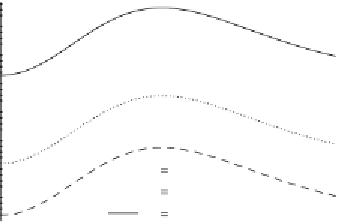Environmental Engineering Reference
In-Depth Information
d
1
w
b
1
b
2
1
0.8
0.6
0.4
0.2
z
d
1
1
2
3
4
0.2
0.4
(a)
γ
0.25
k
0.5
1
1.5
2
0.25
0.5
0.75
1
P
0
1.25
P
1
P
0.5
1.5
(b)
Figure 6.9. (a) Example of kernel function [Eq. (
6.19
)] used to model the spatial
dynamics of facilitation-competition, (b) relation between growth factor
γ
and wave
number
k
of linear perturbations of
v
0
in solutions of (
6.21
) calculated for different
values of
P
, i.e., of the probability of not being in water-stressed conditions (
ζ
=
0
.
4;
χ
=
2
.
0;
=
0
.
25;
η
=
1
.
454). Figure taken from
D'Odorico et al.
(
2006c
).
Near-neighbor interactions facilitate vegetation survival and growth because of the
favorable environment existing in the subcanopy soils, e.g., higher moisture contents
(
Walker et al.
,
1981
;
Greene et al.
,
1994
;
Scholes and Archer
,
1997
;
Zeng et al.
,
2004
). Long-range interactions are dominated by competitions between lateral root
systems, which expand beyond the vertical projection of the canopy (e.g.,
Casper
et al.
,
2003
;
Caylor et al.
,
2006
). At any point
r
(
x
,
y
) in a 2D domain
, the effect
of interactions with vegetation at another point
r
(
x
y
) is assumed to be proportional
to the biomass of the neighboring vegetation and to a weight function
,
w
(
z
)ofthe
, between
r
and
r
. This weight function [Fig.
6.9
(a)] is
positive for relatively small values of
r
(facilitation) and negative at larger distances
(competition). In the absence of relief, the spatial interactions [and hence the function
w
r
|
distance,
z
=|
z
|=|
r
−
(
z
)] depend on the length but not on the direction of the displacement vector
z
, i.e.,
the process is isotropic. An integral formulation (see Section
6.2
) is used to account
for the effect of the interactions with vegetation existing at all points
r
(
x
,
y
)in



































Search WWH ::

Custom Search